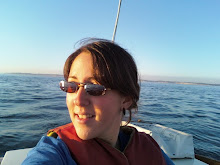If you are in the Puget Sound region, I highly recommend going to one of the events put on by the Puget Sound Chapter of the American Cetacean Society. The next one is happening on Wednesday, May 20th in Seattle, Washington. This free event is held in Room 6 at the Phinney Neighborhood Center (6532 Phinney Ave. N., Seattle). Doors open at 7 and the program begins at 7:30. See below for program description -- and witty title!
Tales from the field: The lifestyle of a not so rich and famous marine mammal observer
Laura Morse, of NOAA Fisheries Service's National Marine Mammal Lab, will talk about what it's like to live in the field and her experiences on projects around the world. She will share photos, video and acoustic recordings of the rare and beautiful species studied and observed.
Laura Morse joined the Cetacean Assessment and Ecology Program at the National Marine Mammal in the spring of 2008. Laura is the field team leader for aerial surveys conducted in the Beaufort and Chukchi Sea and provides support for additional field research effort within CAEP. Laura has degrees in biology and anthropology from SUNY, Buffalo, NY and is currently working on a Masters in Coastal Zone Management through Nova Southeastern University, Florida. Prior to joining NMML, Laura spent the past 14 years working as a marine mammal field biologist worldwide on aerial, shipboard and land/ice based projects. She has participated in multiple large scale cetacean abundance surveys throughout US waters, the Norwegian Sea, Southern Ocean, Western Pacific, Indian Ocean and Asian waters and has specialized experience in field identification, photo-id and passive acoustics. Laura's favorite hobby in the field is photography of marine life , images from her collection will be presented here.


